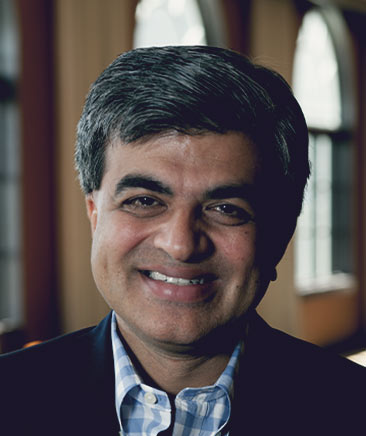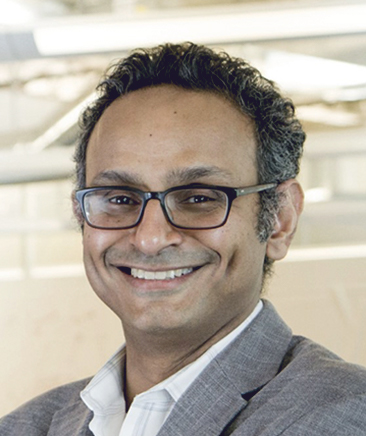“AI won’t replace doctors, but doctors with AI will replace doctors without AI.” This idea has become an article of faith for those of us who believe AI is poised to radically transform healthcare. But what if it’s only half true?
Consider this:
- Roughly half the world’s 8 billion people are not covered by essential health services, leading to millions of preventable deaths each year—including 20 million to cardiovascular disease alone.
- Even in regions where doctors are plentiful, they are struggling to manage incoming health data. According to the 2024 ZS Future of Health Report, physicians report being overwhelmed with data.
- The only way to permanently bend healthcare’s cost curve is for countries to shift health spending from sick care to well care. Yet access barriers and poor patient experiences drive millions to avoid the healthcare system until they become sick. And many countries can’t afford to fund high-quality preventive care for everyone anyway.
Doctors aren’t going anywhere. But there aren’t enough of them, forcing us to make a choice: We can resign ourselves to unsustainable levels of healthcare spending, growing health disparities and tens of millions of preventable deaths each year caused by healthcare provider scarcity. Or we can inaugurate a new era of healthcare abundance by using AI and other technologies to plug the gaps.
But while doctors with AI will replace doctors without it, equipping doctors with AI won’t be enough on its own to cure our healthcare woes. We’ll also need to devise new forms of healthcare delivery and reimbursement to solve for when there are too few providers to support high-quality care for everyone.
Luckily, our growing need for AI-enabled healthcare delivery coincides with an explosion of available AI tools and capabilities. Take Google’s latest experimental large language model, which matched or bested human physicians in all six diagnostic categories tested as well as 24 out of 26 conversational measures. Or Kardia, a company whose home heart monitors are FDA-cleared to diagnose more than a half-dozen arrhythmias using AI.
Too few doctors, too much data and limited prevention: Why we need to heal healthcare
Today, it can take nearly two decades for medical innovation to become standard practice. We’re experiencing the convergence of the coming “gray wave” of aging demographics, the aftereffects of the COVID-19 pandemic and the growing global disease burden from obesity and other symptoms of modern life. We can’t afford to wait for prevailing healthcare customs to catch up with the evolution technologies such as AI makes possible. Here are three reasons why:
The doctor shortage
In April 2023, India became the world’s most populous country, with 1.43 billion people (to China’s 1.4 billion). But the country also holds another, more dubious distinction: It has roughly 600,000 fewer doctors than its population requires to meet its basic health needs—a large chunk of the roughly 2 million additional doctors the World Health Organization estimates we need. The predictable result is egregious health inequities and widescale, unnecessary suffering and death.
The doctor shortage isn’t confined to low- and middle-income countries. In the U.S., as many as one in three healthcare consumers lack access to primary care. Even in the heart of one of the U.S.’s wealthiest cities, Massachusetts General Hospital has stopped accepting new patients because it can’t hire enough primary care physicians (PCPs). Our Future of Health Report found that more than one in four healthcare consumers, across six major economies and multiple demographic groups, avoid care altogether because of various access barriers.
The data deluge
Even where physician supply and healthcare infrastructure are robust, doctors struggle with the explosion of data produced by individual patients and new clinical research. The sum of all medical knowledge is projected to increase by a factor of 1.26 quadrillion between 2020 and 2030, while the average hospital generates about 50 petabytes of patient data annually—more than double the volume contained in the U.S. Library of Congress. No wonder our ZS Future of Health Report has found every year that roughly three in four doctors say they’re overwhelmed with patient data. It seems clinically relevant, they told us, but most of them lack the tools, training and capacity to put it to good use.
The prevention gap
Global health spending is already at record levels. In our Future of Health Survey, 65% of healthcare consumers and 80% of PCPs across the U.S., U.K., China, Japan, Germany and Sweden said they believe boosting prevention is critical to improving healthcare experiences and outcomes. Yet, in both the U.S. and Europe, governments allocate only around 3% of their total health spend to primary preventive health—far short of the 14% health policy researchers say would be ideal. The reason: misplaced priorities, misaligned incentives and missing doctors.
AI can help us deliver healthcare in a world with too few doctors—but only if we create a foundation for developing, approving and building trust in the thousands of algorithms we’ll need to power a future of healthcare abundance.
3 barriers to the use of AI in healthcare
In low- and middle-income countries, the barriers to AI-empowered healthcare delivery are frustratingly familiar: insufficient resources and underdeveloped technological and data infrastructure. In wealthy countries, the barriers come from an overlapping mix of entrenched institutional interests that perpetuate the status quo, even when the status quo is unsustainable. Three barriers stand out:
Lack of trust. Three in four U.S. patients don’t trust AI in healthcare. But patient trust in AI comes down to whether doctors trust it, because patients by and large trust their doctors to make informed decisions about their treatment. Unfortunately, doctors aren’t there yet. Until policymakers establish frameworks for validating healthcare AI, doctors will remain skeptical too.
Regulatory and reimbursement challenges. The doctor sits at the center of a network of interactions through which services and payments flow. Digital health technology and AI may eliminate the need for doctor involvement in many situations, especially for routine services—which would streamline treatment times and reduce costs. But as the hallowed venture capitalist and serial health entrepreneur Vinod Khosla says, “Someone’s cost is someone else’s profit.” Any healthcare transformation that challenges the doctors’ central position in this ecosystem—and, by extension, their income—will face resistance from the healthcare establishment.
Healthcare providers will be motivated to adopt digital health and AI tools based on a variety of factors, including their perceived clinical and operational value as well as a desire to improve patient experiences (and thus outcomes and satisfaction). In the U.S., financial incentives—how likely insurance is to cover a given service and for how much—also play a role while, outside the U.S., many doctors are overworked salaried employees lacking bandwidth to incorporate new tools into their clinical practice. In both Europe and the U.S., a tangle of interdependent stakeholders—from legislators and regulators to public and private payers, patient groups, evidence-based medicine experts and lobbying groups like the American Medical Association—help determine which medical services will be reimbursed, under what circumstances and for how much.
No wonder roughly eight in 10 doctors we surveyed identified reimbursement uncertainty as their top reason for not adopting connected health solutions (and, by extension, AI). Until medical billing codes and clinical guidelines catch up with technology, the status quo will hold.
Justifying the investment
Preventive health is critical to containing long-term spending, reducing health disparities and extending global lifespans and health spans. So, why don’t healthcare systems do more of it? It comes down to ROI.
In low- and middle-income countries, it’s often a “simple” question of lack of resources. But in wealthy countries, we face three barriers. First, the timescale involved: Given our fragmented healthcare system, the entity that makes the investment (be it health insurer, medical provider, employer or government) is unlikely to be the one to reap the reward years or decades in the future. Second, lack of guaranteed return: While subsidizing gym memberships or providing healthy food may reduce downstream health events for some, it may not for others—especially give the myriad interrelated variables that drive long-term health outcomes. And third, the need for scale: Population health interventions must scale to a country’s entire population, so even if the per-person expenditure is small, as it often is, the total investment is massive.
However, most preventive health measures do not require a doctor to supervise them. We could be using a combination of AI and community health workers to dramatically boost preventive health efforts.
Ushering in an era of AI-powered healthcare abundance
Reimagining something as complex, unwieldly and entrenched as today’s healthcare system, especially in the U.S., is an arduous undertaking. But the health of this and future generations is at stake. And doctors are onboard with AI’s promise, citing reduced administrative burden, improved patient education and accelerated diagnoses as the top three areas AI can help improve healthcare delivery, per our Future of Health Report.
Although thousands of minute details lie beneath the surface, we recommend stakeholders prepare to undertake three major shifts.
Shift no. 1: Offer free, AI-based primary care for everyone who wants it
In our January 2024 report for the World Economic Forum, business and technology leaders from across healthcare identified patient triage as among the top use cases for generative AI. Indeed, research published recently in Nature found that Google’s large multimodal model (LMM) matched or bested human doctors at both making accurate diagnoses and demonstrating empathy.
AI’s ability to engage with patients at scale opens the door to free, unlimited AI-based primary care for all who want it. This doesn’t mean primary care doctors would cease to exist; rather, in this scenario, AI could be used to triage the tens of millions who lack primary care access as well as those in nonemergency situations where seeing a PCP is inconvenient or unfeasible. The AI tool would screen these millions of patients, ordering tests or common medications for some, giving a clean bill of health to others and recommending a subset for human primary or specialty care.
Tools like this are currently being tested—for instance at the University of Rochester, where researchers have built a generative AI-powered tool that can appropriately triage patient electronic health record messages roughly nine out of 10 times.
Given its computational abilities, AI should be able to deliver proactive primary care based on capturing the right patient data, integrating it with external medical knowledge and making healthcare recommendations based on the probabilities of what may happen months, years or even decades in a patient’s future. This is what RhythmX AI and Sentara Health, a nonprofit integrated delivery network in Virginia, are aiming to do with their hyper-personalized primary care tool. Powered by both generative and classical AI, the tool combines clinical and payer guidelines with patient electronic medical record data to deliver next best clinical action recommendations at the point of care—wherever that may be.
Using AI to deliver first-mile care would accomplish four things: It would eliminate access barriers for tens or even hundreds of millions of people. It would create legions of patients newly empowered to proactively manage their long-term health. It would enable healthcare systems to shift focus and resources to more specialized areas of healthcare, such as oncology, neurology and high-value human primary care. And it would enable all doctors to practice at or near the top of their licenses.
If tools like these work for primary care, there’s no reason why AI won't eventually play a similar role in guiding long-term care, aging in place and managing common chronic conditions.
Shift no. 2: Create a generation of AI-enabled doctors by reinventing medical school
For specialists such as oncologists and neurosurgeons, there will no longer be any such thing as a doctor without AI—only doctors with AI. However, now that the average age of U.S. doctors is 59, it’s probably not reasonable to expect them all to incorporate AI into their medical practices. And in any case, as many as one in five PCPs and specialty doctors plan to retire in the next five years. Enabling legions of AI-enabled doctors will fall to medical schools.
In a study conducted before generative AI burst into public consciousness, more than 70% of medical students agreed they need AI training—yet very few medical schools offer it. Thankfully, that’s changing. Some medical schools, such as the University of Toronto’s, have recognized the gap by incorporating AI and machine learning into their medical school curricula.
So just as today’s doctors are trained to use modern testing and instrumentation, tomorrow’s doctors will be trained to rely on AI for many tasks it can perform better than humans—things like predicting the future course of disease based on medical imaging, discovering and developing personalized drugs and diagnosing neurological disease using deep brain-computer interfaces.
Shift no. 3: Create the conditions for safe, trustworthy AI
The literature is rife with algorithms that have mastered specific medical tasks like detecting cancer. But there’s no shortage of cautionary tales about false positives, bias and concerns over patient privacy. Doctors, tellingly, don’t yet fully trust it.
This is because there’s no uniform framework for proposing, validating and approving healthcare algorithms. This must be rectified. In a healthcare system built on the idea of doctors plus AI, there won’t be a few algorithms or even a few dozen—there will be thousands. These algorithms will need to demonstrate not only reliability but also transparency and lack of bias.
The challenge—everywhere, but especially in the U.S.—is the fragmented nature of our healthcare systems, which leave patient data sitting in disconnected silos spread across healthcare providers, payers, government and life sciences companies. This challenges our ability to share and integrate data as well as to validate the transparency and competency of the algorithms these data produce—and not just if they work but with which patients and in what environments.
Whether it’s a government or a consortium of healthcare stakeholders, someone must step in to create the mechanisms for building, vetting and demonstrating responsible healthcare AI. Today, this authority doesn’t exist. The EU’s landmark AI Act and the Coalition for Health AI (a consortium of technology companies such as Microsoft and Google, plus federal regulators) are both steps in the right direction. But we need to do more to build a healthcare system that is prepared to adapt to future changes.
Optimism for a future of healthcare abundance thanks to AI
While barriers stand in the way of a future of healthcare abundance supported by AI-enabled doctors, there are enough rays shining through the cracks to make us hopeful. Here are just a few positive examples:
- New regulations in the U.S. would, for the first time, reimburse healthcare providers in some cases where an algorithm looks at data and makes a determination. This should soften provider resistance, leading to more widespread adoption of AI in the clinic and—in turn—increased patient trust.
- Insurers are introducing new billing codes that allow a nurse to review data that previously required a doctor’s eyes to obtain reimbursement. Where before it wouldn’t have been worth a doctor’s time to review certain kinds of data at the contracted rate, the economics may now start to make sense.
- The U.S. Food and Drug Administration has proposed regulations that would allow patients, for certain common conditions, to self-select, self-test and self-prescribe safe, inexpensive medications. This will open up additional doctor availability by lowering demand for primary care, building a key bridge to the future of health we all want.
- Value-based care companies like Iora Health have pioneered a care model centered on community health workers providing unlimited preventive health to its Medicare members. The model has been successful enough that One Medical—the membership-based primary care practice now owned by Amazon—bought it in 2021 for $2.1 billion. Models like this demonstrate that the economics of preventive health can work.
- Initiatives like Project Anemia, which ZS has spearheaded with Indian nonprofit Shrimad Rajchandra Love and Care, pioneer novel approaches to healthcare in environments without adequate doctor supply. This project (and others like it) show what’s possible when technology is paired with community health workers to deliver culturally appropriate, last-mile care without the need for extensive medical training—in this case, by employing local workers (mostly women) to test for and mitigate against anemia, which affects more than 600 million in India alone.
The pathway to a future of plentiful healthcare thanks to AI-enabled doctors may be daunting, but both the underlying need and far-reaching promise are too great to ignore. But equipping doctors with AI only will only get us partway. We also must reimagine healthcare delivery to ensure there are doctors tomorrow for everyone who needs them and secure the future of health we desire.
Add insights to your inbox
We’ll send you content you’ll want to read – and put to use.















